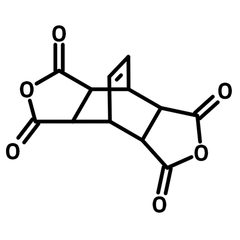Bicyclo(2.2.2)oct-7-ene-2,3,5,6-tetracarboxylic acid dianhydride (COeDA)
CAS Number 1719-83-1
Chemistry Building Blocks, COF Ligands, Diamines and Dianhydrides, Heterocyclic Building Blocks, Materials, MOF Ligands,A dianhydride with a bicyclooctene core
Mainly used as an intermediate for the preparation of imides and MOFs in application of molecular scaffolds, carbon fixation, and supramolecular architectures
Specifications | MSDS | Literature and Reviews
Bicyclo(2.2.2)oct-7-ene-2,3,5,6-tetracarboxylic acid dianhydride (COeDA, CAS number 1719-83-1) has a bicyclooctene fused with two succinic anhydrides. The rigidity of Bicyclo(2.2.2)oct-7-ene-2,3,5,6-tetracarboxylic acid dianhydride enables it to be a robust molecular scaffold for derivatization. COeDA can be derivatised by amines for succinimides while the octene favors electrophilic substitution and olefin metathesis. An inhibitor made from COeDA has shown effectiveness (half maximal inhibitory concentration IC50 = 102.2 µM) against SAR-CoV-2 main protease in the inhibition assays. The succinimide derivatives have shown blue/violet fluorescent under UV radiation, hence they can be applied in bioimaging to monitor their bioactivity.
COeDA is used to synthesize metal organic cages (MOCs) ligands. The lantern-type MOCs have record high surface area up to 521 m2/g. Those metal organic complexes can catalyze reaction of CO2 and epoxides for the purpose of carbon fixation.
For multi-functional materials
High surface area, carbon fixation and fluorescent dye
Carboxylic acid dianhydride building block
For the synthesis of MOF and polyimides
Worldwide shipping
Quick and reliable shipping
High purity
>99% High purity
General Information
| CAS Number | 1719-83-1 |
| Chemical Formula | C12H8O6 |
| Full Name | Bicyclo(2.2.2)oct-7-ene-2,3,5,6-tetracarboxylic acid dianhydride |
| Molecular Weight | 249.19 g/mol |
| Synonyms | 4,10-Dioxatetracyclo[5.5.2.02,6.08,12]tetradec-13-ene-3,5,9,11-tetrone |
| Classification / Family | Dianhydride building block, Polyimides, Molecular scaffolds, MOFs |
Chemical Structure

Product Details
| Purity | >99% |
| Melting Point | Tm = 382 °C |
| Appearance | White to pale yellow powder/crystal |
MSDS Documentation
Bicyclo(2.2.2)oct-7-ene-2,3,5,6-tetracarboxylic acid dianhydride (COeDA) MSDS Sheet
Literature and Reviews
-
Design, synthesis and evaluation of fused bicyclo[2.2.2]octene as a potential core scaffold for the non-covalent inhibitors of SARS-CoV-2 3CLpro main protease, B. Herlah et al., Pharmaceuticals, 15, 539(2022); DOI: 10.3390/ph15050539.
-
Porous metal-organic cages based on rigid bicyclo[2.2.2]oct-7-ene type ligands: synthesis, structure, and gas uptake properties, B. Suso et al., Chem. Eur. J., e202300732(2023); DOI: 10.1002/chem.202300732.
-
Structural design of Mn-metal-organic frameworks toward highly efficient solvent-free cycloaddition of CO2, H. Li et al., Cryst. Growth Des., 21(7), 3728–3735(2021); DOI: 10.1021/acs.cgd.1c00037.
